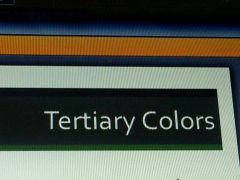![]()
![]()
![]()
Use LEFT and RIGHT arrow keys to navigate between flashcards;
Use UP and DOWN arrow keys to flip the card;
H to show hint;
A reads text to speech;
33 Cards in this Set
- Front
- Back

|
red-violet,
blue-green yellow-orange created by mixing a primary color with a secondary color |
|
|
hue
|
the same of a color.
hue doesn't change when creating a tint or a shade, just the value changes. |
|
|
tint
|
add white to a hue=tint
|
|
|
shade
|
add black to a hue=shade
|
|
|
monochromatic
|
uses only one hue. add tints and shades
|
|
|
analogous
|
use colors next to each other on the color wheel.
|
|
|
complementary
|
use of two colors that are opposite each other on wheel.
when complementary colors are studied side by side their intensity is heightened. |
|
|
split complementary
|
the use of a color and the two colors on either side of the he complement
|
|
|
double complementary
|
use of two sets of complementary colors
four colors to use may cause visual confusion use 1 or 2 of the colors as dominant forces and the others as accents |
|
|
triad
|
use of three colors on the wheel
choose one dominant color. |
|
|
color families
|
divides into: warm and cool
advancing and receding neutral |
|
|
warm colors
|
red, orange, yellow, pink, rust, and peach
|
|
|
cool colors
|
blue, green, violet, and blue-green
cool, calm, aloof, receding colors |
|
|
brown
|
feels warm, relaxing, and boring.
|
|
|
balance
|
symmetrical and asymmetrical
|
|
|
emphasis creating dominance
|
size
repetition unique placement contrast - within contrast 5 different types proportion rhythm - 5 different rhythm types |
|
|
what are the 5 different forms of contrast?
|
size
light and dark contrast shape contrast textual contrast - pair smooth fabric with rough background directional contrast - objects facing different directions instead of all facing the same direction. |
|
|
strategies within composition to create visual flow...
|
repetition
continuous line progression radiation alternation |
|
|
progression
|
graduation of line, color, shape, size
|
|
|
radiation
|
movement radiates from a central point, spokes of a wheel
|
|
|
alternation
|
red and white stripes of the American flag
|
|
|
rhythm= energy of visual flow. how do you create it?
|
self-contained movement from element to element, from background to foreground, from side to side. should lead the viewers eye from the dominant object to the subordinate object.
|
|
|
what is promotion?
|
a term often used in marketing.
Promotion should raise awareness of a product or brand to generate sales. |
|
|
what are the three objectives of promotion?
|
1) to present info to consumers
2) to increase demand 3) to differentiate a product |
|
|
what is branding?
|
use of a name, sign, symbol, design, or experience to identify and tell a story about goods, services, and/or sellers.
|
|
|
what are the 5Ps of brand identity?
|
product
property product presentation promotional activities people |
|
|
product
|
material goods can be repeatedly experienced by the consumer.
|
|
|
product presentation
|
changeable elements surrounding and enhancing goods or service and packaging.
|
|
|
brand extension
|
leveraging awareness and brand image to foster consumer acceptance of other product lines or brands
|
|
|
co-branding
|
linking of two or more brands for mutual benefit into a siNile product or service.
|
|
|
what is the goal of a window display?
|
attract attention in order to bring prospective shoppers closer to the window and then convince them to come in the store.
|
|
|
attention grabers
|
scale
repetition humor nostalgia motion surprise shock |
|
|
graphics in visual merchandising
|
refers to oversized photographs, blowups, light-box art, artwork, sketches, and enlarged prints.
|

